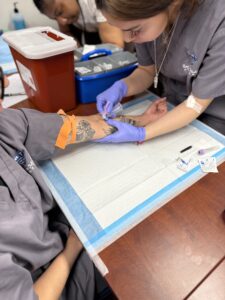Class Calendar | Call admissions on 415-943-2028
Get free phlebotomy training—exclusively for eligible Amazon Associates / Find MA training at BAMA
Class Calendar | Call admissions on 415-943-2028

Working behind the scenes, phlebotomists play an essential role in patient diagnosis and treatment. If you’re curious about this career path, you’ve likely asked, “Phlebotomy—what is it?” In this post, we’ll see what phlebotomy involves, how to become certified, and why it’s a great entry into the medical field.
Phlebotomists are responsible for drawing blood samples from patients as instructed by physicians or other health care professionals. These blood draws may be done in one of three ways: either through skin puncture, venipuncture, or arterial puncture. A phlebotomist’s duties don’t stop after drawing blood. They also must accurately label, track, and send blood samples to the appropriate location. Phlebotomists in certain positions may also have to take on some specialized responsibilities specific to their area of medicine. Phlebotomists can be found working in hospitals, clinics, research, or mobile laboratories in addition to other healthcare facilities.
Getting certified involves completing a phlebotomy training program followed by passing a national certification exam. These phlebotomy programs are offered by vocational schools, community colleges, and some healthcare organizations. Courses traditionally cover anatomy, venipuncture techniques, patient interaction, infection control, and specimen handling.
Most California phlebotomy programs can take between four to twelve weeks to complete, but the length of the program depends largely on the particular school. An approved phlebotomy program will meet the following minimum classroom, clinical, and practical training standards for someone with no on-the-job experience:
If you do have on-the-job phlebotomy experience, there’s some room to reduce the hours of classroom training required for certification. You may also be able to use some of that on-the-job experience to meet clinical requirements. For those individuals, a phlebotomy refresher course can help them get their certification even faster.
In California, several national certification bodies are recognized by the California Department of Public Health (CDPH) for phlebotomy certification. These include National Center for Competency Testing (NCCT), American Certification Agency (ACA), American Medical Certification Association (AMCA), American Medical Technologists (AMT), American Society for Clinical Pathology (ASCP), and the National Healthcareer Association (NHA).
To qualify for most phlebotomy certification exams, you’ll need:
As California requires phlebotomists to be licensed, you’ll also need to obtain a Certified Phlebotomy Technician 1 (CPT 1) license if you want to work as a phlebotomist. Once you’ve completed your education and training, examination, and obtained your certification, you can apply for your CPT-I license, as California requires phlebotomists to be licensed before they can work. This license will authorize you to do venipuncture and skin puncture blood collection. The California Department of Public Health offers an online application portal where phlebotomists can submit their applications as well as check and submit their prerequisites, such as education transcripts, experience details, and other certifications, for consideration.
If you’ve been wondering, “Phlebotomy—what is it and how do I get started?”, the answer is simple: it’s a rewarding, fast-track career with minimal barriers to entry. With the right training and certification, you can step into a stable, in-demand role that truly makes a difference in patient care. At BAMA Institute, our full phlebotomy technician course is broken down into 60 hours of classroom training and 40 to 160 hours of clinical practice in an externship. Our refresher course is shorter and is based on that student’s specific experience. In either case, our program exceeds California standards. We know that’s the best way to create competent phlebotomists and set them up on the path to success. Contact us about BAMA Institute’s accredited phlebotomy technician course.
"*" indicates required fields
© 2024 BAMA Institute. All Rights Reserved. Website by WindsAndWater